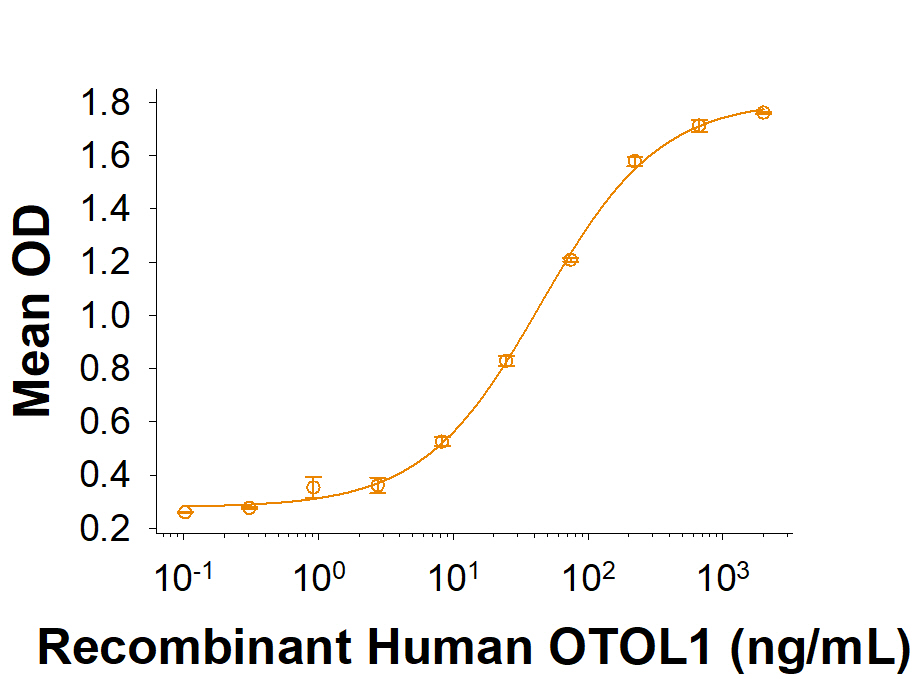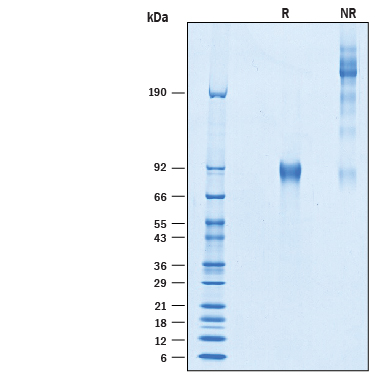Recombinant Human Otolin-1 His-tag Protein, CF Summary
Product Specifications
Lys24-Pro477, with a C-terminal 6-His tag
Analysis
Product Datasheets
Carrier Free
CF stands for Carrier Free (CF). We typically add Bovine Serum Albumin (BSA) as a carrier protein to our recombinant proteins. Adding a carrier protein enhances protein stability, increases shelf-life, and allows the recombinant protein to be stored at a more dilute concentration. The carrier free version does not contain BSA.
In general, we advise purchasing the recombinant protein with BSA for use in cell or tissue culture, or as an ELISA standard. In contrast, the carrier free protein is recommended for applications, in which the presence of BSA could interfere.
10234-OT
| Formulation | Lyophilized from a 0.2 μm filtered solution in PBS with Trehalose. |
| Reconstitution | Reconstitute at 500 μg/mL in PBS. |
| Shipping | The product is shipped at ambient temperature. Upon receipt, store it immediately at the temperature recommended below. |
| Stability & Storage: | Use a manual defrost freezer and avoid repeated freeze-thaw cycles.
|
Scientific Data
 View Larger
View Larger
When Recombinant Human PLA2G2A (Catalog # 5374-PL) is immobilized at 1 μg/mL, 100 μL/well, Recombinant Human Otolin-1 (Catalog # 10234-OT) binds with an ED50 of 20-100 ng/mL.
 View Larger
View Larger
2 μg/lane of Recombinant Human Otolin-1 His-tag (Catalog 10234-OT) was resolved with SDS-PAGE under reducing (R) and non-reducing (NR) conditions and visualized by Coomassie® Blue staining, showing bands at 84-94 kDa and oligomers, respectively.
Reconstitution Calculator
Background: Otolin-1
Otolin (OTOL1), also known as C1qTNF15, is an approximately 65 kDa protein found in the otoconial membrane lining the cochlea and vestibular labyrinth of the inner ear (1). It is secreted by supporting cells of the sensory epithelium. The otoconial membrane contains particles known as otoconia which are composed of glycoproteins and proteoglycans coated with calcium carbonate crystals. Otolin is one of the protein components of otoconia particles, and it is important for otoconia formation as well as for auditory and vestibular function (1). It associates into multimers and disulfide-linked oligomers and also associates with other otoconial proteins including and Otoconin-90 (also known as PLA2G2A, PLA2L, and phospholipase A2 homolog) and Cerebellin-1 (1-3). Otolin contains three collagen-like regions followed by a C1q-like domain at the C-terminus (4). It is extensively glycosylated and has multiple hydroxylated proline residues in the collagenous regions. Human Otolin shares 72% amino acid sequence identity with mouse and rat Otolin.
- Moreland, K.T. et al. (2014) PloS one 9:e95333.
- Zhao, X. et al. (2017) Dev Biol 304:508.
- Yang, H. et al. (2011) PLoS ONE, 6(5):e20498.
- Tang, Y. T. et al. (2005) Genomics 86:100.
FAQs
No product specific FAQs exist for this product, however you may
View all Proteins and Enzyme FAQsReviews for Recombinant Human Otolin-1 His-tag Protein, CF
There are currently no reviews for this product. Be the first to review Recombinant Human Otolin-1 His-tag Protein, CF and earn rewards!
Have you used Recombinant Human Otolin-1 His-tag Protein, CF?
Submit a review and receive an Amazon gift card.
$25/€18/£15/$25CAN/¥75 Yuan/¥2500 Yen for a review with an image
$10/€7/£6/$10 CAD/¥70 Yuan/¥1110 Yen for a review without an image
